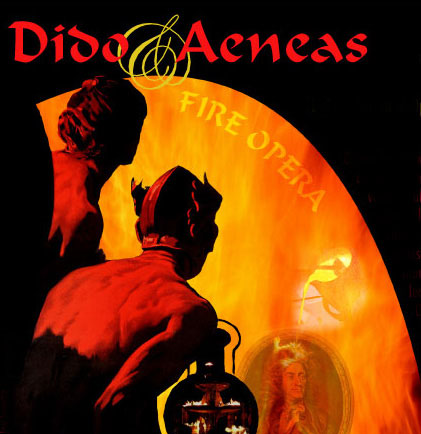SpearheadNews.com
Super News
2003-2004

Auditions
Events
Rehearsal Schedules
Interviews
Photos
Reviews
More Fun Stuff!
The
Super Handbook
Tips, Tricks, and FAQs
San
Francisco Opera
Links
Classifieds
Contacts
Archives
Members Only
Spearheadnews.com is not officially affiliated with any
performing arts organization.
All photographs remain the property of their copyright holders.
©2003 SpearheadNews
All Rights Reserved
Dido & Aeneas Flame On
Review by Michael Harvey
It seemed like a wonderful combination: a seventeenth-century opera, Henry Purcell's Dido & Aeneas, performed in a 30,000 sq.ft. warehouse, accompanied by exhibitions of molten metal casting, glass blowing, fire eating, and belly dancing. Billed as a Fire Opera and with Roy Rallo directing I knew we were in for something very special.
There were two huge lines an hour before the doors opened at The Crucible. A few thousand of us with tickets in one - and a similar number hoping for standing room in the other. We finally entered and made our way through an arch and up a ramp into the vast, glittering space. If any Spearhead readers of a certain age remember �Night Flight� or any of the decadent gay party extravaganzas of the late 70's they will be able to picture the scene: strobes, searchlights, and lots of twinkle-lights amid tattooed, pierced, costumed and bewigged partygoers of all persuasions and flavors. It did not call to mind any recent event at the Opera House.
Seating was unreserved so we snagged a couple of spots on the aisle, house left, in a performance area reminiscent of the Civic Center's a few years back. The stage was long and shallow with the pit upstage center, and the audience spread out in very wide rows. Standing room had no direct view of the stage and turned out to be a vicarious party experience in front of big projection screens in the bar area. It was all a bit haphazard - but nobody cared.
Our seats were perfect since all of the entrances passed right by us. The show started with dozens of belly dancers screaming and generally doing a Greek chorus kind of thing. A couple of hunky Supers were pushing a big fountain-like sculpture ridden by a woman who might have been Mercury, the Spirit of the Sorceress. With sparks flying, a giant gantry holding a huge crucible of real molten metal soared over the audience and was lowered to the stage so that artists, in silver protective gear, could pour the flaming stuff into a mold. This turned into the magic spear used by Aeneas later in the show. A glass artist then fired up a torch and created a gorgeous glass "wand" for Dido. It seems that Dido was trying to decide whether or not to elope with Aeneas. I couldn't tell for sure since there were no supertitles and my knowledge of Greek mythology doesn't go much beyond Aesop. See Ulrica's notes.
According to the Stanford University Libretto database, Dido & Aeneas was first performed in 1689 at Mr. Josias Priest's Boarding School for Young Gentlewomen so we were amazed to see a procession of bare-breasted Valkyries sporting flame-spouting antlers. Soon the flying gantry arrived again carrying a magical ship full of pirates, and lots of swordplay ensued between some jolly sailors and Aeneas. From time to time a huge metal tree would whirl and blue lights would twinkle as handmaidens pumped pistons into cylinders that produced strange moaning sounds. Just to keep us from getting bored, a giant forklift entered stage right supporting two aerialists who did amazing trapeze tricks and some astounding stuff with a long piece of red fabric.
During one ethereal aria Dido shot skyward on a concealed neon-ringed scissor lift. This was followed by a couple of magic thunderstorms during which a Wagnerian horn-helmeted god would pop up from a big copper structure and bang on sheets of steel hanging from the ceiling. Oh, and there were plenty of big orange sparklers and other pyrotechnics constantly going off. After all this, Dido decided not to go with Aeneas, and her friends Belinda and the Sorceress helpfully set her on fire. This was not some lame auto-da-fé with fluttering red cloth lit from below: This was an enormous roaring pyre six feet high that seemed to consume the mezzo in no time and threatened the audience and a good part of Oakland's warehouse district with immolation. Fire Opera, indeed!
During all of this there was also some really wonderful music. The San Francisco Bach Soloists and choir were directed by maestro Jeffrey Tate. Dance and spectacle were provided by Mark Growden, Xeno, Ultra Gypsy and members of The Crucible faculty and artists. Dido was exquisitely sung by SFO Adler Fellow mezzo-soprano Katherine Rohrer. Adler Fellow Greta Feeney, soprano, was Belinda, and SFO soloist Shawnette Sulker was also featured as the Sorceress. The show was directed by SFO AD Roy Rallo and produced by The Crucible's Michael Sturtz.
If there is another Fire Opera next year, insert your best metal body ornaments, dye your hair orange, break out your asbestos cape and be first in line for an incredible evening of theater.

Program notes provided by Ulrica -
Aeneas is on his way home after the Trojan Wars and pulls into Carthage and meets Dido, the Queen. After a few months of decadently lounging around with her, his men want to return to Greece to their loved ones and eventually Aeneas agrees to do so. As his ship pulls out of the harbor Dido throws herself on a pyre.